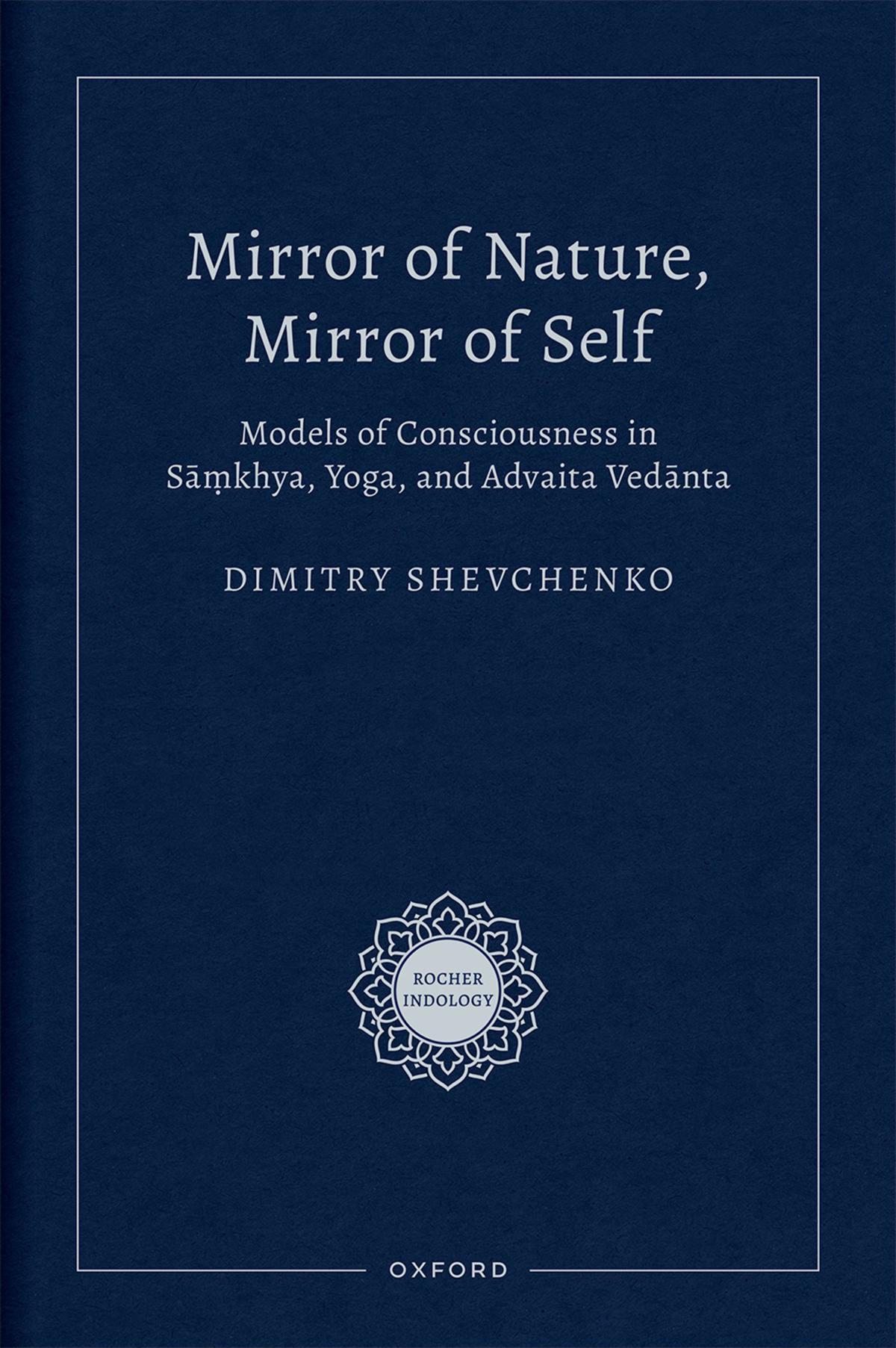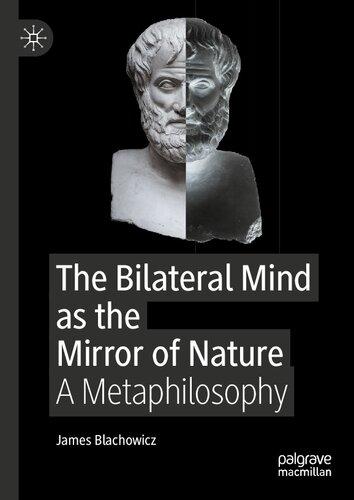ROCHER INDOLOGY SERIES
Serieseditor:Patrick Olivelle
Widows Under Hindu Law
David Brick
Mirror of Nature, Mirror of Self
ModelsofConsciousnessinSāṃkhya,Yoga,andAdvaitaVedānta
Dimitry Shevchenko
Mirror of Nature, Mirror of Self
Models ofConsciousness in Sāṃkhya, Yoga, and Advaita Vedānta
DIMITRY SHEVCHENKO
Oxford University Press is a department of the University of Oxford. It furthers the University’s objective of excellence in research, scholarship, and education by publishing worldwide. Oxford is a registered trade mark of Oxford University Press in the UK and certain other countries.
Published in the United States of America by Oxford University Press 198 Madison Avenue, New York, NY 10016, United States of America.
© Oxford University Press 2023
Some rights reserved. No part of this publication may be reproduced, stored in a retrieval system, or transmitted, in any form or by any means, for commercial purposes, without the prior permission in writing of Oxford University Press, or as expressly permitted by law, by licence or under terms agreed with the appropriate reprographics rights organization.
This is an open access title available under the terms of a CC BY-NC-ND 4.0 International licence. It is free to read at Oxford Academic and offered as a free PDF download from OUP and selected open access locations.
CIP data is on file at the Library of Congress
ISBN 978–0–19–766551–0 eISBN 978–0–19–766553–4
DOI: 10.1093/oso/9780197665510.001.0001
The whole world is inside the self, like a city visible in a mirror.
One sees it withinoneself as if arising outside due to illusion, like in a dream. Dakṣiṇāmūrti Stotram 1
Contents
Acknowledgments
Introduction
1.Mirror Models of Consciousness in Early Sources and Indian Philosophical Systems
1.1Early Vedic Metaphysics of Image Formation
1.1.1Vedic Metaphysics of Resemblance
1.1.2The General Condition of Phenomenal Representation (GCPR)
1.1.3The General Condition of Phenomenal Formation (GCPF)
1.2The Mirror Model of Consciousness in the Chāndogya Upaniṣad
1.3Mirror Models in Buddhism
1.4Metaphysical Approaches to Reflection in a Mirror
1.4.1Sarvāstivādins and Dārṣṭāntikas: The Debate on the Reality of Reflection
1.4.2Nyāya and Mīmāṃsā: The Reflected Image Is Nothing but the Prototype Object
1.4.3Śāntarakṣita and Kamalaśīla: The Reflected Image Has No Objective Support
1.4.4Pratibimbavāda in Kashmiri Śaivism
2.Consciousness Reflects the Mind, the Mind Reflects Consciousness: Mirror Models in Sāṃkhya and Yoga
2.1Sāṃkhya-Yoga Metaphysics
2.2Reflection in the Mental Faculty
2.2.1External Objects
2.2.2The Self
2.3. Reflection in the self
2.4Vijñānabhikṣu’s Double-Reflection Theory
2.5Mental Representation of the Self in Yoga (Asmitā)
2.6K.C. Bhattacharyya’s Interpretation of Mutual Reflection Theory
2.7Summary
3.One Consciousness, Many Mirrors: Mirror Models in Advaita Vedānta
3.1Non-dualist Theories of Reflection before Śaṅkara
3.2Śaṅkara’s Theories of Reflection
3.2.1Śaṅkara’s Theory of Brahman’s Reflection in Jīva
3.2.2Śaṅkara’s Theory of Reflection in the Upadeśasāhasrī
3.3Pratibimbavāda
3.3.1Padmapāda’s Theory of Reflection
3.3.2Pratibimbavāda: Later Developments
3.4Summary
4.New Mirrors: Indian Theories of Reflection, Jacques Lacan, and Thomas Metzinger
4.1Lacan’s Mirror Models
4.1.1The First Reflection: The Ego
4.1.2The Model of Two Mirrors
4.1.3Second Reflection: Consciousness
4.1.4Mirror Stage in Perspective: Wallon and Lacan
4.1.5Lacan: Summary
4.2Thomas Metzinger’s Representational Theory of Pure Consciousness
4.3Reflection in a Mirror and the Hard Problem of Consciousness
4.4New Theories of Consciousness-Matter Dualism, Mirror Interactionism, and Representationalism
Abbreviations
References
Index
Acknowledgments
This book evolved from my PhD dissertation at the University of New Mexico, and my first debt of gratitude goes to scholars who inspired, read, and argued with ideas, developed in this first version of my study of Indian mirror models of consciousness: John Taber, who has patiently accompanied the project from scratch to its realization as a dissertation, read closely and insightfully the drafts, and assisted with difficult Sanskrit passages; and Adrian Johnston, who energetically and sympathetically guided me through the intricacies of Lacanian psychology and philosophy. John Bussanich and Sthaneshwar Timalsina were the first readers and judges of the final draft of the dissertation and their penetrating observations were invaluable for improving the manuscript while turning it into a book. I would like to thank Idris Robinson, Christopher Rahlwes, Mariah Partida, Marcel Lebow, and Pierre-Julien Harter for the stimulating conversations and the opportunities to articulate still half-baked ideas as clearly as possible. For the administration of the University of New Mexico, I would like to thank Mercedes Nysus for her gentle and efficient handling of the organizational aspects.
Special thanks go to David Shulman and Daniel Raveh for reading chapters from the book and offering comments. I am thankful to Yigal Bronner, Mrinal Kaul, Maayan Nidbach, Evyatar Shulman, Roy Tzohar, Dor Miller, Elise Coquereau-Saouma, James Madaio, Agnieszka Rostalska, Karl-Stephan Bouthillette, Nino Qilarjiani, Naphtali Meshel, Nikolaus Wildner, and Albert Lu for supporting the writing and the submission of this book to publication in many ways. I am grateful to Patrick Olivelle, Cynthia Read, and Paloma Escovedo at Oxford University Press for their interest in the manuscript and for their patient efforts to make its publication happen. I would like to thank the anonymous reviewers, whose
illuminating suggestions contributed to the improvement of the book. I am thankful to the Ludo and Rosane Rocher Foundation for the wonderful opportunity to be able to publish as a part of its Indological series. My thanks also go to Nirenjena Joseph and the Newgen Digital Works team, who have gently and efficiently dealt with the production process.
This project has received funding from the European Research Council (ERC) under the European Union’s Horizon 2020 research and innovation program (grant agreement no. 786083—NEEM). Along with a fellowship from the Israeli Ministry of Aliya and Integration’s Center for Absorption in Science, the funding allowed me to complete my research for this book and present it at international forums.
Finally, I am thankful to my parents Sergei and Mira, my sister Anna; and above all to my wife Micka and my daughters Ella and Maya Simran, whose love, endurance, and companionship have made this book possible.
Introduction
How did reflection in a mirror become the predominant metaphor for consciousness and its relation with the mind and the world in Indian philosophy? Which role did it play in the major systems of Sāṃkhya, Yoga, and Advaita Vedānta, and in their debates with other philosophical schools? And what makes this metaphor philosophically interesting and relevant even for contemporary philosophical concerns?
The first mirrors in India were, probably, pools of water, rock or clay containers of water (Enoch 2006:775), and ice.1 Bronze-made flat or circular mirrors appeared around 2000 bce during the Indus Valley civilization at Quetta and Harappa in today’s Pakistan and Dholavira in Gujarat. The reflectivity of these mirrors varied and depended on the proportion of tin mixed with bronze (Srinivasan 2008:1699). To achieve a highly reflective surface, they needed to be polished for an entire day (Pillai 1992:39).
The reflective quality of mirrors afforded them a host of symbolic meanings and usages. Mirrors have been widely used in religious ceremonies and works of art; they played roles in poetry, prose, and drama (Granoff 2000:63–106; Goswamy 20202). In Vedic society, mirrors were believed to avert evil. During the wedding ceremony, the bridegroom placed a mirror in the left hand of the bride, stating “Each form of him has become a counter-form; that form of him we should look on.”3 Gonda suggests that this quote from the Ṛgveda may imply that the bride “reflects” the divine or primeval bride (Gonda 1980:150).
The symbolic use of mirrors, of course, is not unique to Indian culture. In Europe, from ancient history to this day, mirrors have assumed a variety of symbolic functions. They have symbolized truth and purity, but also the distortion of the truth (Pines 1998:20). In India, China, and Europe, in poetry and in philosophy, the mirror
serves as the main metaphor for the mind representing the external reality (Pines 1998:20–21; Ching 1983:226–244).
While we find depictions of the mind as the “mirror of nature” in Indian philosophy, it is the image of the mind as the mirror of consciousness that gained prominence in what is known as pratibimbavādas, or “theories of reflection.”4 The metaphor stands for the idea that, just as a face, reflected in a mirror, appears where it is not, so do consciousness and its properties, such as the sense of self, subjectivity, and experience of qualia, stand in falsely perceived relations to cognitive and perceptive processes. As I will show in this monograph, the metaphor became a widespread metaphysical instrument used to address metaphysical, epistemological, and theological problems arising from a non-reductionist approach to consciousness. I will explore various models of interaction between consciousness, the mind-body complex,5 and the world, based on the metaphor of reflection, in the Brahmanical philosophical schools of Sāṃkhya, Yoga, and Advaita-Vedānta, which share historical and conceptual continuities.
As opposed to the much-neglected field of Brahmanical philosophy of consciousness, scholarship on the Buddhist philosophy of consciousness has been flourishing for the last few decades.6 From the perspective of contemporary philosophy of mind, much of the appeal of Buddhist theories seems to lie in their reductive approach.7 The Buddhists take consciousness to be nothing more than dynamic cognitive processes, thereby resonating with the widespread resistance among modern philosophers to hypostatization and reification of consciousness. In classical India, the major objections to Buddhist reductionism came from the Brahmanical philosophical traditions. Brahmanical interlocutors of the Buddhists, especially those representing Sāṃkhya, Yoga, and Advaita-Vedānta schools, defended the radical ontological independence of consciousness, perceived as a phenomenal monad, unified and permanent. Their side in the centuries-long debate with Buddhism on the nature of consciousness is the subject of this book. Brahmanical nonreductionist theories of consciousness have much to contribute to
contemporary debates on consciousness, precisely because they present a viable alternative to the shortcomings of reductionist theories.
The major Buddhist criticism of Brahmanical theories of consciousness has been that an entity ontologically independent from mental and physical processes cannot interact with these processes in any way, while our experience tells us that consciousness is engaged in the acts of perception, cognition, imagination, etc. Moreover, postulation of consciousness as separate from mental processes is redundant, whereas it could be perfectly well ascribed to the mental faculty. Gradually, the metaphor of mirror reflection gained currency in Sāṃkhya, Yoga, and Advaita-Vedānta as the most successful response to Buddhists attacks. Any types of relations between consciousness, the mind, and the world are merely apparent: like the relation between the mirror and reflected objects— they are not real. At the same time, the mirror model explained the intentionality of mental states as “reflecting,” or representing the objects of cognition.
Despite the overwhelming presence of “theories of reflection” (pratibimbavādas) in the major philosophical traditions in India, they have received little attention in scholarship to date. Mirror ofNature, Mirror of Self is the first systematic exploration of mirror models of consciousness in Sāṃkhya, Yoga and Advaita-Vedānta. By grounding these theories in their historical intellectual context, the book sheds a new light on an intense philosophical conversation between Indian reductionists and non-reductionists about consciousness. The book explores the impact of Indian mirror models on theories of mental representation, theories of knowledge, philosophy of language, debates on illusory causality and on the relationship between noumena and phenomena, as well as soteriological and theological theories. My reading of the classical texts on mirror models of consciousness draws not only on traditional commentaries, but also on the “commentaries” of a contemporary Anglophone Bengali interpreter, Krishna Chandra Bhattacharyya (1875–1949), whose studies in Sāṃkhya and Yoga have hardly been discussed, perhaps due to the notorious difficulty of his philosophical style. It is about
time that Bhattacharyya’s interpretations of these traditions become part of the discourse. Finally, by comparing mirror models of consciousness in Indian philosophy with Jacques Lacan’s theory of the mirror stage and by engaging with theories of consciousness in analytic philosophy, the book contributes to contemporary debates. Hopefully, the findings of the present research will be fruitful also for the future study of those theories of reflection, with which I engaged in this monograph only in passing, such as highly interesting theories of pratibimba in Madhyamaka and Yogācāra Buddhism, Kashmiri Śaivism, Madhva’s Dvaita-Vedānta, etc.8
Richard Rorty, in his influential PhilosophyandtheMirrorofNature, criticizes the usage of mirror imagery by modern philosophers and its implication that philosophy can “reflect” reality based on reliable vehicles, such as “minds” or “language.” Rorty calls this representationalist (in a broad sense) view “philosophy-asepistemology” (2009:18) and points out that various philosophical problems, such as the problem of mind and matter, or problems of knowledge, stem from using a particular philosophical vocabulary rather than from a difficulty to articulate the actual state of affairs. The formulation of epistemological problems rests on the false assumption that there is some foundational framework for knowledge, a general theoryof knowledge, whereas in fact there are only context-sensitive, pragmatic, toolsfor producing knowledge.
It is the notion that human activity (and inquiry, the search for knowledge, in particular) takes place within a framework which can be isolated prior to the conclusion of inquiry—a set of presuppositions discoverable a priori—which links contemporary philosophy to the Descartes-Locke-Kant tradition. For the notion that there is such a framework only makes sense if we think of this framework as imposed by the nature of the knowing subject, by the nature of his faculties or by the nature of the medium within which he works. [ . . . ] The notion that there could be such a thing as “foundations of knowledge” (all knowledge—in every field, past, present, and future) or a “theory of representation” (allrepresentation, in familiar vocabularies and those not yet dreamed of) depends on the assumption that there is some a priori constraint. (2009:9)
Rorty’s argument is partially based on genealogy of philosophy-asepistemology, which he traces to the seventeenth century, in particular to Locke’s notion of “mental processes,” and to Descartes’s notion of the “mind” as a separate entity in which these processes take place (3). Thus, philosophy-as-epistemology, with its representationalism, should not be seen as various attempts to solve eternal philosophical problems, but rather as building upon certain notions of the mental entity and processes, which have come to be regarded as conceptually significant only in the modern period.
Curiously enough, what Rorty calls “philosophy-as-epistemology” is found not only in Western modern philosophy, nor his criticism of such a view is entirely new. One of the claims put forward in the present study is that mirror metaphors used in the context of theories of cognition in Sāṃkhya and Yoga, and to some extent in Advaita Vedānta, are various kinds of representationalism about the mind, the external objects, and consciousness. The general approach of “philosophy-as-epistemology,” known in India as pramāṇavāda, has been vehemently criticized by Nāgārjuna already in the third century ad. At the same time, in classical Indian philosophy, we find various arguments against the very application of mirror imagery as an appropriate description of epistemic, metaphysical, and cognitive relations between consciousness, the mind, and the external objects. Mirror-model theorists are aware of these criticisms, as well as of the many ways in which language may mislead or misrepresent, due to its inherent structure. Their view of philosophy and of language, however, is thoroughly optimistic. It is important to identify the potential ways of misrepresenting the reality and the ways in which we superimpose our concepts and notions upon what is real. Yet the possibility of apprehending the real is also there and should not be given up. The fact that Indian representationalism precedes Lockean philosophy of the “mirror of nature” by many centuries somewhat softens Rorty’s historicism. This is precisely where a comparative cross-cultural approach to philosophy is indispensable: both claims to universality of Western philosophy and its historical relativization can only be substantiated by careful examination of parallel notions from non-Western traditions. Are there differences between Lockean and
Sāṃkhya representationalist theories? No doubt. Are the concerns of modern philosophy attempting to come to terms with scientific discoveries different from the soteriological, metaphysical, and sectarian concerns of Brahmanical philosophers? Yes, they are different. Are similarities between Western and Indian theories close enough to classify both as kinds of representationalism? I believe they are. Moreover, these similarities, coupled with differences, justify an exploration of representationalism as a universal philosophical position, allowing for varieties and alternatives.
The book’s overall structure is guided by historical and philosophical concerns. As one of the primary goals is to narrate a history of mirror models of consciousness in Indian philosophy, the contents of the book are organized chronologically and according to particular philosophical schools. This approach enables a description of the relatively long and rich development of theories of reflection in India, showing historical and conceptual continuities, as well as contextualizing these theories in the debates within philosophical traditions, responses to opponents, standardized arguments, and original contributions. At the same time, historical textual exploration of mirror models is the basis for my own philosophical interpretation, assessment of, and engagement with the arguments behind these models.
In Chapter 1, I will present a historical background of mirror models of consciousness in Indian philosophy. The point of departure will be the early Vedic theory of resemblances between human and divine realms. I will argue that later theories of reflection preserve the general structure of the Vedic model of formal causation. After that, I will turn to the early theory of reflection in the Chāndogya Upaniṣad in the famous story of Prajāpati’s instruction to Indra and Virocana. In the following sections of this chapter, I will survey reductionist mirror models in Buddhism, as well as mirror models in Nyāya, Mīmāṃsā, and Kaśmiri Śaivism. These sections are dedicated to mapping various positions, differing on the interpretation of the optical process involved in reflection in a mirror, and its implications for the phenomenon of consciousness and its relations with mental processes and the objects of cognition.
Chapter 2 will explore the philosophical traditions of Sāṃkhya and Yoga, which developed a notion of mirror reflection to explain the illusory interaction between consciousness and the mind, regarded as ontologically distinct entities. These two schools made an implicit connection between the mental representation of external objects by the mind and the mental representation of consciousness. The chapter discusses early theories of external objects reflected in the mind, consciousness reflected in the mind, and the mind reflected in consciousness in the Yogasūtrabhāṣya, attributed to Vedavyāsa (fourth-fifth centuries ce), as recorded in Bhavya’s Madhyamakahṛdayakārikā (sixth century ce), in the Yuktidīpikā (seventh to eighth centuries ce), and other texts, presenting entirely unexplored theories of reflection. It also sheds a new light on the later Vācaspati Miśra’s (tenth-century) theory of reflection of consciousness in the mind and Vijñānabhikṣu’s (sixteenth-century) theory of mutual reflection of consciousness in the mind and then back in consciousness. Finally, it engages, for the first time, with the philosophically creative, but little-known interpretation of theories of reflection in Sāṃkhya and Yoga by Krishna Chandra Bhattacharyya. Chapter 3 focuses on the non-dualist tradition of Advaita-Vedānta, which holds that the multiplicity of individual selves is nothing but reflections of one transcendent self. This school develops the notion of ahaṃkāra (the “I-maker”) as an entity supervenient upon the illusory identity between the mind and consciousness and mediating between the two. The chapter examines, for the first time, Śaṅkara’s (seventh to eighth centuries’) non-dualist reinterpretation of the Sāṃkhya model of consciousness reflected in the mind, its development by Padmapāda (eighth to ninth centuries), with further elaborations by Prakāśātman (eleventh to twelfth centuries), as well as later developments (mirror models of one consciousness reinterpreted in terms of identity between the god and individual selves, reported by Appayya Dīkṣita in the sixteenth century). The texts composed by these philosophers, representing what came to be known as the Vivaraṇa sub-school of Advaita, have been seriously understudied to date.
Chapter 4 takes a foray into a modern mirror model of consciousness, namely Lacan’s theory of the mirror stage. According to Lacan, the interplay between one’s reflection in a mirror and the “intra-organic mirror” located in the cerebral cortex is responsible for the mechanism of identities between objective and subjective contents in the formation of the individual. By comparing Lacan’s theory with Indian mirror models, the chapter brings forward the ontological basis of mirror-like interaction between consciousness, the mind, the society, and the world—that is, the illusory identity of different entities. The chapter also negotiates with Thomas Metzinger’s representational theory of consciousness to construct a plausible theory of mental representation of consciousness, based on Indian mirror models, and suggests that such a theory provides a tenable solution to the hard problem of consciousness. In this chapter, I demonstrate the plausibility of non-reductionism about consciousness proposed by Brahmanical philosophers—plausibility enhanced by mirror models. As I argue, mirror models of consciousness developed in Sāṃkhya, Yoga, and Advaita-Vedānta convincingly ward off not only Buddhist objections, but also some of the objections coming from contemporary philosophers, such as Jaegwon Kim’s arguments against metaphysical dualism. Finally, I defend a new model of consciousness, integrating consciousnessmatter dualism, mind naturalism, and representationalism about consciousness.
1 Mentioned in Abhinavagupta’s Īśvarapratyabhijñā-vivṛti-vimarśini. I would like to thank the anonymous reviewer for this reference.
2 I would like to thank Patrick Olivelle for the latter reference.
3 rūpaṁ-rūpam pratırūpo babhūva tad asya rūpam praticakṣaṇāya/indro māyābhıḥ pururūpaīyateyuktāhyasyaharayaḥśatādaśa//(ṚV 6.47.18).
4 Plotinus is an example of a non-Indian theory of the mirror model of consciousness. He applies metaphors of reflection in various ways, some of which are rather similar to those found in Indian philosophy. Thus, he renders the myth of Narcissus falling in love with his own image as a metaphor for a person identifying with his or her own material body, which
is nothing but a reflection of the soul, the only worthy object of one’s attention (Davidson 1998:9–10).
5 As opposed to Buddhist theories of consciousness, the Brahmanical theories usually distinguish between consciousness and the mind. Consciousness, or the self, is an ontologically independent substratum of awareness and subjectivity, whereas the mind is a mental “sense,” or “instrument,” responsible for cognitive, apperceptive, introspective, and other mental “activities,” passively witnessed by consciousness.
6 Some of the titles that can be mentioned here include Dan Arnold’s Buddhas, Brains, and Believing: The Problem of Intentionality in Classical Buddhist and Cognitive‐Scientific Philosophy of Mind (2012, 2014); Zhihua Yao’s The Buddhist Theory of Self‐Cognition (2005), Dan Lusthaus’s Buddhist Phenomenology: A Philosophical Investigation ofYogācāra BuddhismandtheCh’engWei‐shihlun(2002); Miri Albahari’s AnalyticalBuddhism:TheTwo‐Tiered Illusion of Self (2006); Christian Coseru’s Perceiving Reality: Consciousness, Intentionality, andCognitioninBuddhistPhilosophy (2012); Mark Siderits’s PersonalIdentity and Buddhist Philosophy: Empty Persons (2003); and William S. Waldron’s The Buddhist Unconscious: The Ālaya‐vijñāna in the Context of Indian Buddhist Thought (2003). One should also mention Jonardon Ganeri’s excellent The Self: Naturalism, Consciousness, and the First-Person Stance (2006, 2012), where he discusses naturalist theories of self and consciousness in Buddhism, Cārvāka, and Nyāya. Research on Brahmanical non-reductionist theories of consciousness does not keep up with the wealth of literature on Buddhist theories produced in recent years, and the present study aims at minimizing the gap. Some aspects of consciousness in Sāṃkhya and Yoga have been discussed in Mikel Burley’s Classical Sānkhya and Yoga: An Indian Metaphysics of Experience (2007). Sthaneshwar Timalsina explores consciousness in the Dṛṣṭisṛṣṭi school of Advaita Vedānta in his Consciousness in Indian Philosophy: The Advaita Doctrine of ‘Awareness Only’ (2009). Another book on consciousness in Advaita-Vedānta is Bina Gupta’s TheDisinterestedWitness: AFragmentof AdvaitaVedāntaPhenomenology(1998). Her other book about theories of consciousness in Indian philosophy is Cit:Consciousness(2003).
7 For a thorough and critical discussion of the recent trend to read Buddhism as reductionism in the spirit of Derek Parfit, see Hanner 2018.
8 On Abhinavagupta’s (tenth- to eleventh-century) theory of reflection, see Lawrence 2005 and Kaul 2020. On a theory of reflection in Kashmiri Śaivism, see Ratié 2017 and Kaul’s PhD dissertation (unpublished). On Madhva’s (thirteenth-century) theory, see Sharma 1986:438–448. On Buddhist theories of reflection, see Wayman 1971 and 1984.
Mirror Models of Consciousness in Early Sources and Indian Philosophical Systems
1.1 Early Vedic Metaphysics of Image Formation
The subject of this section is the early Vedic theory of resemblances between human and divine realities and its explanation of the appearance of forms in human reality. I will argue that the concepts of pramā (model, prototype) and pratimā (counterpart, image), as well as their correlatives rūpa (form) and pratirūpa (counterform) must be seen as conceptual predecessors of the later bimba (prototype) and pratibimba (reflection). I will demonstrate that the later theories of reflection preserve the general structure of the early Vedic model of formal causation, according to which the images of the phenomenal reality resemble the original forms of the noumenal reality. I will also show how the transition from metaphysics of resemblance in the early Vedas to metaphysics of identity in the Upaniṣads prepares the ground for the Upaniṣadic theories of reflection.
1.1.1 Vedic Metaphysics of Resemblance
One of the recurrent topics in the Vedic textual corpus, starting with the Saṃhitā and ending with the Upaniṣads, has been the correct identification of cosmic connections (bandhu/nidāna/upaniṣad) between different phenomena (Smith 1989:72). In early Vedic cosmology, sacrificial activities were considered to have a powerful impact on cosmic events, and sacrifice was intended not only for
bringing about personal benefits and protection, but also for maintaining the cosmic order, without which chaos would persist and the universe would collapse into the demonic nonbeing (asat) (RamPrasad 2001:9–11; Goman and Laura 1972:56–57). In the Brāhmaṇas, the understanding of the precise relations between the elements of the ritual and cosmic reality was regarded a necessary condition for the success of the offering. These relations were based on resemblances between the individual components of the sacrifice and particularities of divine and mythical realities, as well as between the overall structure of the sacrifice and the cosmic order in its entirety:
Vedic ritualism was directed toward activating the connections that bind the ritual world to the world(s) at large; the ritual order lends its form to a cosmic order, a universal structure emanating from the structured sequence of rites. (Smith 1989:53–54)
Smith describes two sorts of Vedic connections—“vertical” and “horizontal.” Vertical connections refer to correspondences between the elements found in the higher planes and their correlatives in the human world (Smith 1989:73; Coomaraswamy 1936:45). Horizontal connections link phenomena on the same cosmological level (Smith 1989:73).
The relation between the correspondences is not symmetrical. The elements found in the divine realms are called pramā (model, prototype), while their counterparts in the human world are called pratimā (counterpart, image) (Smith 1989:73, 76). The constant concern of the Vedic experts with the sacrificial-cosmic order has been “What was the prototype (pramā), what was the counterpart (pratimā), and what was the connection (nidāna) between them?” (ka asīt pramā pratimā kiṁ nidānam, ṚV 10.130.3). Thus, it is said that the creator-god Prajāpati, also identified with the material cause of the universe, has emitted the year as a counterpart (pratimā) of his own self (ātman) (ŚB 11.1.6.13). Another counterpart of Prajāpati is the entire sacrifice as a unified whole. Sacrifice, thus, is the symbol
of the universe in its entirety, and its parts are the counterparts of the cosmic parts (ŚB 11.1.8.3; Smith 1989:73–74).
Horizontal correspondences between the prototype and its counterpart appear in the relation between the sacrificer and the sacrificial oblation. Ideally, a sacrificer is expected to sacrifice himself, because he is a counterpart of the primordial cosmic man (puruṣa) sacrificed by the gods. Luckily for him, a substitute in the form of an animal or a plant is permitted. There is a horizontal correspondence between human sacrifice, which becomes a sacrificial prototype, and the animal sacrifice—its counterpart. Although the correspondence is horizontal—the prototype and its counterpart are found in this world yet the two stand in vertical hierarchical relations. While the sacrificer is a counterpart of the primordial cosmic man, as a prototype he is valued higher than the animals or the plants (Smith 1989:75–76).
Another important Vedic terminology of resemblance is the pair of rūpa (form) and pratirūpa (counterform). Closely related to the concepts of pramā/pratimā, rūpa indicates the original form on the transcendent plane, pratirūpa—its image or reflection in the immanent realm. Thus, in the ṚV 6.47.18, it is stated that the god Indra’s form (rūpa) corresponds to every form (rūpa), and everything is regarded as his image (pratirūpa).
Coomaraswamy regards the metaphysics of rūpa/pratirūpa as “Vedic exemplarism” and compares it to Bonaventure’s and other Neo-Platonic idealist theories (1936:44–64). In Bonaventure’s exemplarism, phenomenal realities are explained as emanations and reflections of the universal forms found in god’s mind. In Vedic exemplarism, the forms of the “angelic” level (adhidaivata) are projected and reflected on the “human” level (adhyātma) (45). Smith, however, points out that “pratirūpas or resembling images are made as well as discovered, a phenomenon that tends to distinguish this conception from the Platonic one” (Smith 1989:76). In the sacrificial context, the counterforms are actively constructed as “the works of art (śilpa)” and “made to conformto its model” (77).
Moreover, sacrificial counterforms must conform to prototypes in a special manner called abhirūpa (“appropriate form”): the prototypes
and their images cannot be identical (77). Two potential excesses must always be avoided: the one is called jāmi (excessive resemblance), and another is pṛthak (complete difference). In the ritual context, the elements of excessive resemblance are regarded as “fruitlessly reduplicative within a ritual sequence,” and are compared to a homosexual copulation, a fruitless act of “those too alike.” On the other hand, elements having no connection at all are not even capable of joining with others (Smith 1989:51–52). The appropriate counterpart must resemble the prototype just enough, without being identical or too different. The emphasis on resemblances (sāmānya) between prototypes and their counterparts indicate, for Smith, discontinuity rather than continuity between early Vedic metaphysics of resemblances and metaphysics of identity in the Upaniṣads. While some scholars regard the equation of the self with the cosmos as the logical conclusion of the Vedic searches for the cosmic correspondences, Smith points out that complete identity between correspondences is certainly faulty of being a jāmi, or excessive resemblance, which should be avoided by all means in the early Vedic thought (Smith 1989:194–195).
Smith’s emphasis on the discontinuity between the concepts of resemblance and identity is important. The concept of resemblance allows the hierarchical metaphysics of the Vedas, as well as the sacrificial hierarchical structures. Smith demonstrates this hierarchical resemblance based on the rules of ritual substitution, where complex, expensive, and difficult-to-obtain sacrificial components can be replaced by those simpler, cheaper, and easier to obtain. For instance, instead of the impossible (but ideal) sacrifice of a thousand years, it is permitted to perform its lesser but equivalent counterpart lasting one year only (the tāpaścita ritual) (Smith 1989:186–187; ŚB 12.3.3.5–14). The concept of hierarchical resemblance also makes the metaphysical world formation possible. The creator’s (in this case, Prajāpati’s) unity of form (ekarūpatva) cannot infinitely reproduce its own identical replicas. On the other hand, the creator may not create something completely other to himself, because this otherness must be contained in him at least in its potential form. Any change of form, any diversity of forms in the process of creation may, however, be
explained by gradual decrease of resemblance of creation to its creator. Various forms are less perfect, less complete, but nevertheless somewhat similar to their original.
Smith’s distinction between resemblance and identity duly noticed, we must also pay attention to the moment shared by resemblance and identity. Even if an image is not entirely identical with its prototype, there must be an identical common aspect responsible for their similarity. At the same time, when two elements are said to be completely identical, there must be some difference between the two, making identity akin to resemblance; otherwise, there would only be one element identical with itself. Despite the differences between the concept of “identity” and the concept of “resemblance,” the relation between the two concepts is that of a conceptual continuity rather than of a conceptual break. This continuity is evident in the fact that the model of the transcendent prototype (pramā/rūpa) and its immanent image (pratimā/pratirūpa), as well as the corresponding connection between the two (nidāna/bandhu) survives in the Upaniṣads. Whereas the sacrificial context (adhiyajña) is still of some concern for the authors of the Upaniṣads, the search for the correspondences between the divine realm (adhidaivata) and the “human” level (adhyātma) are increasingly reconceptualized in physiological context. The knowledge of correspondences between the faculties and cosmic phenomena becomes more important than the correspondences between rituals and their divine prototypes (Olivelle 2008:xlix). Although resemblances are replaced by identities, and ritual-centered metaphysics is replaced by anthropocentric metaphysics, the prototype-counterform paradigm is equally shared by Vedic theory of resemblances and the Upaniṣadic theory of identity.
1.1.2 The General Condition of Phenomenal Representation (GCPR)
For the sake of a more rigorous formulation of the Vedic model of correspondences, I would like to propose a methodological distinction between the pairs of pramā/pratimā and rūpa/pratirūpa.1 Pramā-
pratimā-nidāna is the formal ontological framework for the relation between noumenon and its phenomenal representation. Implicit in this relation is the efficient causality of phenomenal representation, the process during which the noumenal is manifested in the phenomenal. I suggest calling the efficient cause of this transformation “māyā.” Although often translated as “illusion,” the word “māyā” in the Vedic texts seems to have a more general and technical meaning of “making pramā into pratimā.” Thus, in ṚV 6.47.18, māyāis mentioned in conjunction with rūpaand pratirūpa: “ . . . the counterform (pratirūpa) of every form (rūpa); his form is to be seen in all things. By means of his māyā Indra moves in various forms” (cited in Mahony1998:42, 43).2 The same verbal root √mā, common to pramā, pratimā, and māyā, suggests a possible conceptual relation between the terms. Perhaps, the original meaning of māyāas “making pramāinto pratimā” has been gradually replaced by “illusion” as the most popular explanation of the divine power to project forms of the adhidaivatalevel into the human realm.
A more general definition of māyā, compatible with my own, has been suggested by Gonda: “incomprehensible insight, wisdom, judgment and power enabling its possessor to create something or to do something, ascribed to mighty beings” (Gonda 1959:126). In a reference to the above quoted-verse from the ṚV 6.47.18, Gonda explains that “māyāhere refers to the special ability to create forms, or rather to the inexplicable power of a High Being to assume forms, to project itself into externality, to assume an outward appearance, to appear in, or as, the phenomenal world” (Gonda 1959:128). Further,
it is perfectly intelligible that this text could be quoted in order to demonstrate that the universe is identity gone into difference, God being the inner ground, the basis of identity, the world the outer manifestation of his being; in order to maintain the opinion that all and everything is a self-revelation, a manifestation, a particularization of the one and sole divine essence. As soon as this doctrine is firmly established māyā may become the mysterious and inexplicable power which screens the One under the mirage of individuality and under the display of the perishable universe; then it is the very energy of the One which enables it, or him, to project or “realize” itself. (Gonda 1959:128–129)
I suggest calling the fourfold scheme of pramā-pratimā-nidāna-māyā the generalconditionofphenomenalrepresentation(GCPR). Each of the components of this scheme must be present to make any act of phenomenal representation possible. The actual content of each of the variables may be contested. For the early Vedic thinkers, pramā usually refers to the forms of the divine realm (adhidaivata), pratimā to their sacrificial counterparts (adhiyajña), and nidāna is the resemblance between the two (sāmānya). Māyā refers to the proper sacrificial performance making this resemblance possible. The innovation found in the upaniṣadic texts is that the pramā becomes the cosmic totality (brahman), the pratimā is its counterpart within the human experience (ātman), and the nidāna is the absolute identity (ekatva) between the two. Māyā is the power of illusion creating the appearance of separateness.
The words pramā and pratimā are based on the verbal root √mā, literarily meaning “to measure.” In later Indian philosophical traditions, the basic epistemological concepts are also based on this root, such as pramā (cognition), pramāṇa (the means of cognition), prameya(the object of cognition), pramātṛ(the cognizing subject). It is possible that the word pramā, which in the Vedic context meant “noumenal prototype” becomes in a more epistemologically precise terminology “cognition of a noumenal prototype,” whereas noumenal prototype becomes more closely associated with prameya (the object of cognition).
Pramā-pratimā-nidāna-māyā is a formal ontological scheme describing the relation between the phenomenal reality and its noumenal source.3 At the same time, it has an epistemological aspect in that true knowledge is defined by properly understanding all the constituents of the condition of phenomenal representation.
1.1.3 The General Condition of Phenomenal Formation (GCPF)
Rūpa-pratirūpa-nidāna-rūpaṇa, on the other hand, can be seen as the generalconditionofphenomenalformation(GCPF), or appearance of distinct forms in the phenomenal realm. Any phenomenon of
formation requires the formal cause (rūpa),4 the formal effect (pratirūpa),5 the persisting relation between the two (nidāna), and the efficient cause of formation (rūpaṇa). I am not familiar with any explicit usage of rūpaṇa in any similar context, but in analogy with māyā, I suggest the term as describing a process by which the formal prototype appears as a particular phenomenal image.
The difference between GCPR and GCPF is a matter of accent. GCPR focuses on the correspondences between the noumenal and the phenomenal realities, and thus has an epistemological aspect. GCPF describes the process of formation, and is, essentially, a theory of formal-efficient causality. The referents of each of the schemas may coincide, but the conceptual emphases are slightly different.
Since the analogy of an image-making may take different forms, the image-making metaphysics of representation appears in different ways. The image of the prototype can be created through the act of art, through casting a shadow, through leaving traces, or through the reflection in a mirror. Thus, the grounds for the future models of reflection based on identity between the prototype and the image (e.g., bimba-pratibimba-ekatva-avidyā) have already been prepared by the early Vedic schemes of pramā-pratimā-nidāna-māyāand rūpapratirūpa-nidāna-rūpaṇa.
The early Vedic theory of resemblances proposes an explanation for the formation of images in the phenomenal realm. The forms found in the divine realm are regarded as prototypes represented in the phenomenal realm as images resembling the original forms. There are correspondences between the divine forms and phenomenal images, but they are not identical. The transition to the metaphysics of identity in the Upaniṣadsallows for the transformation of the prototype-image model into the prototype-reflection paradigm, according to which the two correspondences are identical, although the prototype is real, but the reflection is not.
An important implication of the general condition of phenomenal formation is that there must be a clearly distinguished duality—at least on a conceptual level—between the realm in which prototypes reside and the realm of representations. Whereas the latter world is
filled with projections and representations of the former world, it requires a distinct phenomenal embodiment.
1.2 The Mirror Model of Consciousness in the Chāndogya Upaniṣad
In this section, I will discuss the early mirror model of consciousness from the Chāndogya Upaniṣad (seventh to sixth century BCE),6,7 taught by the creator-god Prajāpati to Indra, the king of gods; and Virocana, the king of demons. Prajāpati maintains that ātman is found beyond the form-counterform correspondences, thus rejecting the possibility that the self, associated with consciousness, is either the noumenal prototype or the phenomenal image. Or, put differently in the new terminology of mirror reflection, the self is neither a reflection nor a reflected thing; by implication, it is that in which all phenomena are reflected.
Chāndogya Upaniṣad 8.7–8.12 recounts that Indra, the king of gods; and Virocana, the king of demons, come to Prajāpati to learn about the self. They seek that self, that is, ātman “that is free from evils, free from old age and death, free from sorrow, free from hunger and thirst; the self whose desires and intentions are real.” Anyone who discovers and perceives the referent of this definition obtains all the worlds and all his desires are fulfilled (Olivelle 2008:171).8
Only after thirty-two years, living as celibate students under Prajāpati, Indra and Virocana get to hear Prajāpati’s answer. “This person that one sees here in the eye—that is the self”—says Prajāpati (Olivelle 2008:171).9 In his commentary on the ChāndogyaUpaniṣad, Śaṅkara explains that Prajāpati has in mind the “seer,” the subject of perceptual experience (ChUBh on CU 8.7.4). Prajāpati’s gesture might also be interpreted in the light of the BṛhadāraṇyakaUpaniṣad2.3.5, where the eye is explained to be the essence of the body, corresponding to the self which is the essence of the “formless” in the body. Either way, Prajāpati’s two students fail to understand their teacher’s intention and mistakenly take the self to be each of their
own reflections in the pupil of Prajāpati’s eye. They ask him who the person reflected in the water and in the mirror is, and Prajāpati answers that it is the same person (ChU 8.7.4).
Now Prajāpati asks his two students to look into a pan of water and tell what they do not see about themselves. Virocana understands that his physical body is the self; Indra thinks that the self is the reflection of his body (according to Śaṅkara’s interpretation) (CUBh on ChU 8.9.1). Prajāpati’s experiment is further complicated when he asks his students to adorn themselves beautifully, dress well, spruce up, and then look into the pan of water again. The two proclaim that “as the two of us here are beautifully adorned, well dressed, and all spruced-up, in exactly the same way are these, sir, beautifully adorned, well dressed, and all sprucedup.”10 Prajāpati confirms that this is the self that his students are looking for (ChU 8.8.1–5; Olivelle 2008:172).
Virocana leaves satisfied with his mistaken understanding of the self as a physical body. Indra, however, doubts that his understanding of the self as a reflection really corresponds to the definition of the self as free from old age and death. His doubts are addressed by Prajāpati by further identification of the self with “the one who goes happily about in a dream” (Olivelle 2008:173).11 After Indra points out that the dreaming person still may experience suffering, and thus does not seem to conform to Prajāpati’s definition of the self, Prajāpati suggests waiting for another thirty-two years (ChU 8.10.1–4).
After thirty-two years, Prajāpati tells Indra that the self is the one found in a deep dreamless sleep. Indra is satisfied with this answer, but on his way to the gods, he understands that there is a problem with the unconscious self, which is not capable of perceiving itself as “I am this.” Prajāpati affirms Indra’s doubts, and proposes waiting “only” five years for his final answer (ChU 8.11.1–3).
After the last five years, Prajāpati gives an elaborate answer: the self is bodiless, and thus is free from all suffering associated with the embodied existence. In order to illustrate the nature of the self, Prajāpati mentions analogies of air, clouds, lightning, and thunder, whose forms are invisible during the winter dry season, and are













